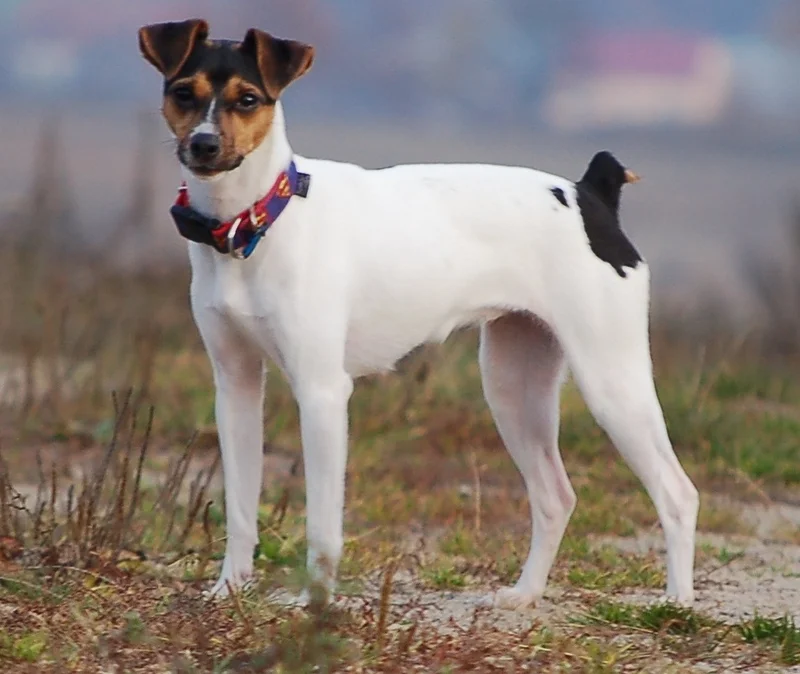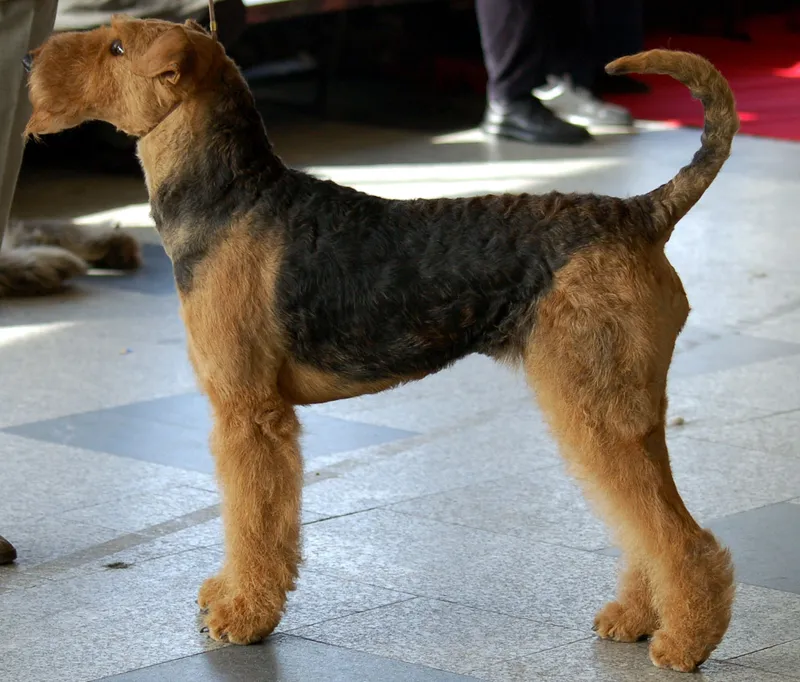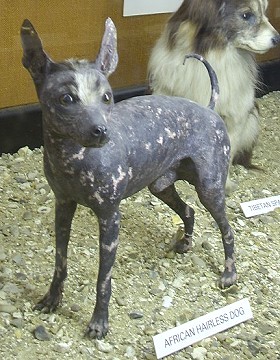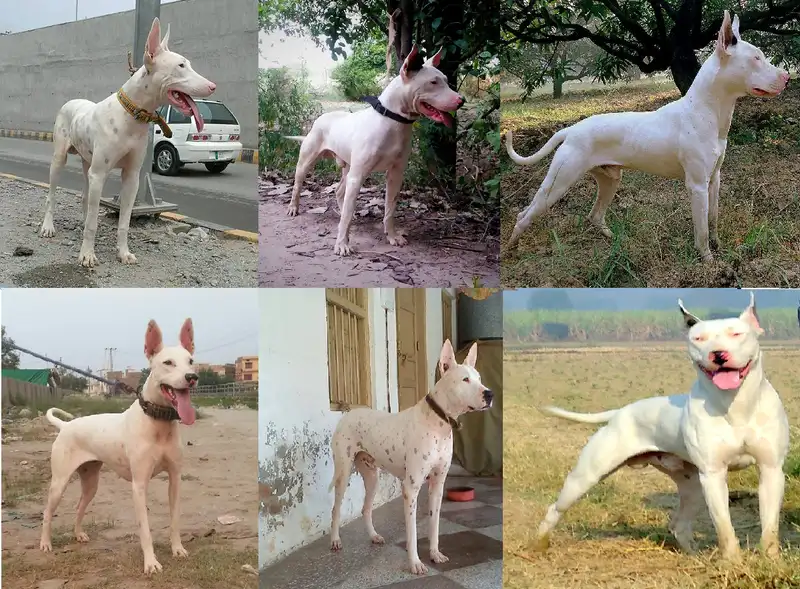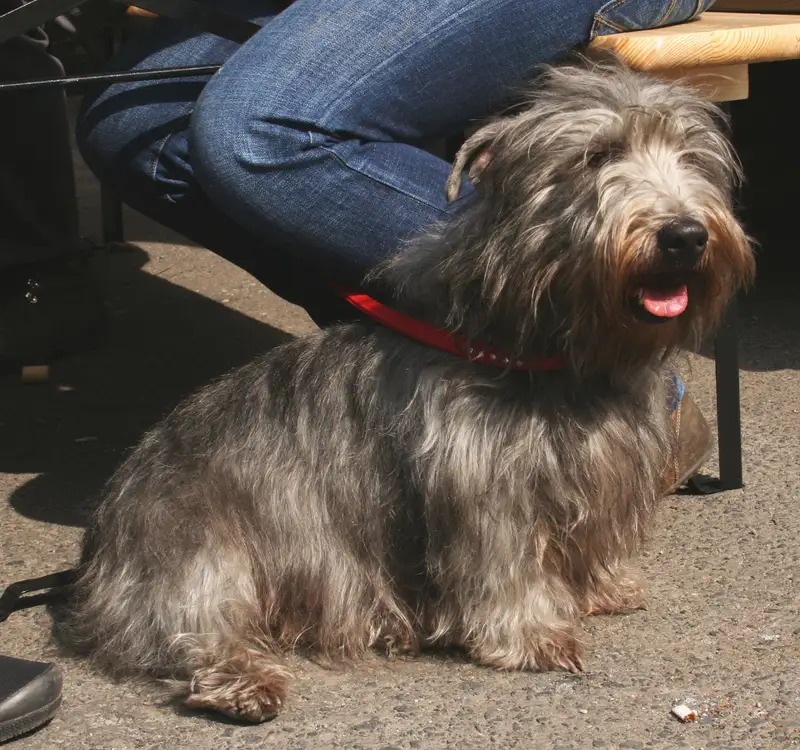Kerry Blue Terrier
The Kerry Blue Terrier is a spirited and intelligent breed known for its striking blue-gray coat. Originally bred for vermin control, they are loyal companions that thrive on exercise and training.
Overview
🐕Breed Overview
✨Key Traits
💡What Makes Kerry Blue Terrier Special
The Kerry Blue Terrier is characterized by its intelligence, loyalty, and playful demeanor. They thrive on mental and physical stimulation, making them excellent candidates for various dog sports and activities.
Their strong prey drive can lead to aggressive behavior towards smaller animals, so careful management and training are essential. Kerries are known for their unique sense of humor, often bringing joy and laughter to their families.
Their versatility as working dogs means they can excel in various roles, from herding to companionship, making them a well-rounded breed.
The Kerry Blue Terrier, often referred to as the Irish Blue Terrier, is a medium-sized breed known for its striking blue-gray coat and spirited personality. Originating from the rugged mountains of Kerry, Ireland, this versatile dog was initially bred for vermin control, herding, and guarding. With a long head, flat skull, and deep chest, the Kerry Blue exhibits a unique appearance that sets it apart from other terriers.
Its soft, wavy coat requires regular grooming and is hypoallergenic, making it a suitable choice for allergy sufferers. Kerries are known for their intelligence and playful nature, making them excellent companions for active families. They are loyal and affectionate towards their owners, often forming strong bonds with children.
However, they can be reserved with strangers and may display aggression towards other dogs, necessitating early socialization and training. Despite their historical significance in Ireland, the Kerry Blue remains relatively uncommon today, yet it excels in various roles, including therapy work, agility, and obedience. Their playful demeanor and sense of humor make them a joy to be around, and they thrive in environments where they can engage in physical and mental activities.
With a lifespan of 12 to 15 years, the Kerry Blue Terrier is a loving and loyal companion that brings joy and laughter to any household.
🎉Fun Facts
Kerry Blue Terriers are born black and develop their blue-gray coat as they mature, usually between 9 months and 2 years.
The breed has been used in various roles, including police work, therapy, and search and rescue.
They are known for their playful and humorous nature, often described as having a 'touch of the blarney.'
Breed Characteristics
Family & Friends
Good Behavior
Get Up & Go
Household Harmony
Temperament & Personality
✨Key Traits
🐕Core Temperament
The Kerry Blue Terrier is known for its spirited and lively temperament. They are loyal and affectionate towards their families, often forming strong bonds with children.
While they can be protective and may show aggression towards other dogs, they are generally friendly with humans. Their playful nature makes them great companions, and they thrive on interaction and engagement.
However, their independent streak can lead to stubbornness, requiring consistent training and socialization to ensure they develop into well-mannered pets.
💫Personality Profile
Kerry Blue Terriers are known for their lively and spirited personalities. They are affectionate with their families and often form strong bonds with children.
While they can be protective of their home and family, they may be reserved around strangers. Their playful nature makes them great companions, and they enjoy engaging in various activities, from fetch to agility training.
However, they can be aggressive towards other dogs and small animals, so early socialization is crucial. Their intelligence and eagerness to please make them relatively easy to train, although they can exhibit stubbornness at times.
🔊Vocal Tendencies
Kerry Blue Terriers are generally moderate barkers. They may bark to alert their owners of strangers or unusual sounds, but they are not known to be excessive barkers.
Their vocalizations can vary depending on their mood and environment. While they may bark during play or when excited, they typically do not engage in constant barking without reason.
Early training can help manage any excessive barking tendencies, ensuring they communicate appropriately without becoming a nuisance.
Affection & Social Traits
Energy & Activity
Communication Style
Care Requirements
🏃♂️Exercise Requirements
Daily Exercise
The Kerry Blue Terrier is an energetic breed that requires daily exercise to maintain its physical and mental well-being. Ideally, they should engage in at least 60 minutes of exercise each day, which can be broken down into multiple sessions. Activities such as brisk walks, playtime in a secure yard, and interactive games like fetch or agility training are excellent for this breed.
Puppies may require shorter, more frequent bursts of activity, while adult dogs benefit from longer sessions that challenge their stamina. Senior dogs may still enjoy moderate exercise but should have their routines adjusted based on their health and mobility. Regular exercise helps prevent obesity, reduces behavioral issues, and promotes cardiovascular health.
Insufficient exercise can lead to destructive behaviors, anxiety, and weight gain, making it crucial for owners to prioritize their Kerry's activity needs.
Preferred Activities
🏠Living & Adaptability
Space Requirements
Kerry Blue Terriers are adaptable to various living environments but thrive in homes with ample space for exercise. They can live comfortably in apartments if provided with sufficient daily exercise and mental stimulation.
However, a house with a secure yard is ideal, allowing them to run and play freely. Owners in smaller spaces should ensure regular outings to parks or open areas to meet their exercise needs.
The breed's size and energy level mean they can become restless or exhibit destructive behavior if confined for long periods, so providing opportunities for exploration and play is essential.
Climate Preference
🍲Feeding Guide
Schedule
Food Types
Portion Size
Special Nutritional Needs
Kerry Blue Terriers may benefit from a diet rich in protein and healthy fats to support their active lifestyle. It's essential to monitor their weight and adjust portions accordingly, especially if they are less active. Some individuals may have food sensitivities, so it's advisable to consult with a veterinarian for personalized dietary recommendations.
✨Grooming Requirements
Grooming Overview
The Kerry Blue Terrier's coat is one of its most defining features, requiring regular grooming to maintain its health and appearance. Their soft, wavy coat does not shed but continues to grow, necessitating brushing at least once a week to prevent matting.
Owners should also schedule professional grooming every 4 to 6 weeks to keep the coat trimmed and shaped. Regular ear cleaning and nail trimming are also essential to ensure overall hygiene.
The beard of the Kerry can absorb water, so keeping a towel handy during mealtime is advisable to prevent mess.
Care Schedule
Brush weekly; professional grooming every 4-6 weeks.
Health Profile
⚕️Health Care
Regular health care is crucial for the Kerry Blue Terrier's longevity. Routine veterinary check-ups, vaccinations, and preventive treatments can help detect health issues early.
Maintaining a balanced diet, providing regular exercise, and monitoring for any changes in behavior or health are essential practices for ensuring optimal health throughout their life stages. Early detection and management of health conditions can significantly impact their quality of life and lifespan.
Health Issues Overview
⏳Average Lifespan
Genetic Factors
Genetics play a significant role in the Kerry Blue Terrier's lifespan, with hereditary health issues impacting their overall health. Responsible breeding practices that prioritize genetic diversity can help reduce the prevalence of certain conditions.
Potential owners should seek breeders who conduct health screenings and provide health clearances for common breed-specific issues. Understanding the genetic background of a Kerry Blue can help owners make informed decisions about their care and management.
Living Conditions
The Kerry Blue Terrier's lifespan can be influenced by various environmental factors, including housing conditions, climate, and social interactions. A stable and loving home environment, along with regular exercise and mental stimulation, can promote longevity.
Exposure to extreme temperatures should be minimized, as Kerries are adaptable but can be sensitive to heat and cold. Social interactions with family members and other pets can also contribute positively to their emotional well-being, potentially extending their lifespan.
🏥Common Health Issues
Keratoconjunctivitis Sicca (Dry Eyes)
Warning Signs
🔬Diagnosis
Veterinarians typically diagnose this condition through a Schirmer tear test to measure tear production.
💊Treatment
Artificial tears and anti-inflammatory medications may be prescribed.
📝Management Tips
Regular veterinary check-ups and eye lubricants can help manage symptoms.
Cataracts
Warning Signs
🔬Diagnosis
Eye examinations by a veterinary ophthalmologist can confirm cataracts.
💊Treatment
Surgery may be required for severe cases.
📝Management Tips
Regular eye exams can help detect cataracts early.
Progressive Neuronal Abiotrophy (PNA)
Warning Signs
🔬Diagnosis
Diagnosis is often made through neurological examinations and genetic testing.
💊Treatment
There is no cure; management focuses on supportive care.
📝Management Tips
Supportive care and monitoring for symptoms are essential.
Hip Dysplasia
Warning Signs
🔬Diagnosis
X-rays are used to diagnose hip dysplasia in dogs.
💊Treatment
Surgery may be necessary in severe cases.
📝Management Tips
Weight management and joint supplements can help alleviate symptoms.
🛡️Preventive Care
🔬Hip Evaluation
This test assesses the dog's hip joints for dysplasia, which can lead to arthritis and mobility issues. Early detection allows for management strategies to be implemented.
📅 Annually after 12 months of age.
🔬Schirmer Tear Test
This test measures tear production to diagnose dry eye conditions, which can lead to discomfort and vision problems. Regular testing helps monitor eye health.
📅 Every 1-2 years, or as recommended by a veterinarian.
🔬Genetic Testing for Progressive Neuronal Abiotrophy
Genetic testing for PNA can identify carriers and affected dogs, helping breeders make informed decisions to reduce the incidence of this condition in future litters.
📅 Before breeding, and as needed for individual dogs.
Training
🧠Intelligence & Trainability
💪Work Drive
Kerry Blue Terriers have a strong work drive and thrive when given tasks to complete. Activities such as agility training, herding exercises, and scent work can provide the mental stimulation they crave.
Their intelligence and eagerness to please make them excellent candidates for various dog sports. Engaging them in activities that challenge their problem-solving skills will keep them happy and fulfilled.
Without sufficient mental and physical stimulation, they may resort to destructive behaviors, so it's essential to provide regular opportunities for them to work and play.
⚠️Training Considerations
Kerry Blue Terriers can exhibit strong-willed and independent behaviors, which may pose challenges during training. Their spirited nature can lead to stubbornness, particularly if they sense a lack of leadership.
To overcome these challenges, owners should establish clear boundaries and use positive reinforcement techniques. Consistency in training is crucial, as is early socialization to help them learn appropriate behaviors around other dogs and pets.
Engaging training methods, such as agility or obedience classes, can keep them motivated and focused. Additionally, addressing any aggressive tendencies towards other animals early on through controlled socialization can help mitigate potential issues.
📝Training Tips
Training a Kerry Blue Terrier requires patience, consistency, and a sense of humor. Start with basic obedience commands and gradually introduce more complex tasks.
Positive reinforcement, such as treats and praise, works best with this breed. Incorporating play into training sessions can enhance their engagement and eagerness to learn.
Socialization is vital; expose them to various environments, people, and other animals from a young age to foster well-rounded behavior. Regular training sessions, combined with mental stimulation through puzzle toys or interactive games, will keep their minds sharp and reduce boredom-related behaviors.
History & Heritage
📜Origin Story
The Kerry Blue Terrier's origins are steeped in folklore, with tales of a blue dog swimming ashore from a shipwreck and mating with local terriers. This romantic narrative, while captivating, lacks concrete evidence.
More likely, the breed was developed by farmers in the Kerry region, who sought a versatile dog capable of herding, hunting, and guarding. The breed's name reflects its geographical roots, and its popularity grew as it proved itself as an all-around farm dog.
The Kerry Blue was first recognized in dog shows in the early 1900s, with the Irish Kennel Club playing a pivotal role in its standardization. The breed's connection to Irish history and culture has solidified its status as a national treasure.
⏳Development History
The Kerry Blue Terrier originated in the mountains of Kerry, Ireland, where it was bred for its ability to control vermin and assist in various farm tasks. The breed's development is shrouded in myth, with stories suggesting it descended from black terriers that swam ashore from shipwrecks.
Over time, the Kerry Blue was refined through selective breeding, incorporating traits from other terrier breeds and possibly the Irish Wolfhound. By the early 20th century, the breed gained recognition in dog shows, leading to a standardized appearance and temperament.
The Kerry Blue's unique coat and charming personality have made it a favorite among dog enthusiasts, although it remains relatively uncommon today.
🛡️Purpose & Historical Role
Originally bred for vermin control, the Kerry Blue Terrier evolved into a versatile working dog, assisting in herding livestock, hunting small game, and serving as a loyal guardian. Its intelligence and agility made it suitable for various tasks, including police work in Ireland.
The breed's adaptability and strong work ethic have allowed it to thrive in different roles, from farm companion to family pet. Today, the Kerry Blue is celebrated for its affectionate nature and playful spirit, making it a cherished companion in homes around the world.
🏺Cultural Significance
The Kerry Blue Terrier holds a special place in Irish culture, often associated with rural life and farming. Historically, it was a versatile working dog, used for herding, hunting, and guarding.
The breed's popularity surged in the early 20th century, particularly during the rise of dog shows in Ireland and the UK. Notably, the breed was championed by Irish nationalist leader Michael Collins, who owned a Kerry Blue named Convict 224.
This connection to Irish history and politics has cemented the breed's status as a symbol of national pride. Despite its decline in popularity, the Kerry Blue remains a beloved companion and working dog, recognized for its intelligence and versatility.
Conservation Status
This breed is less common but has stable populations in certain regions.

